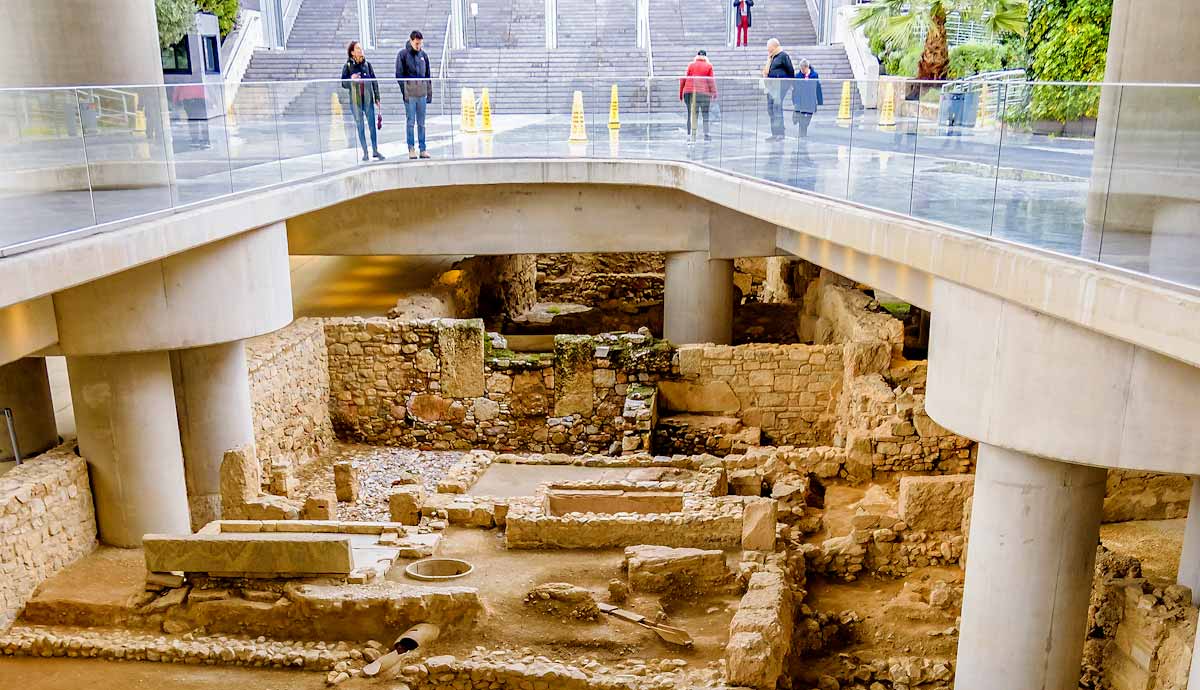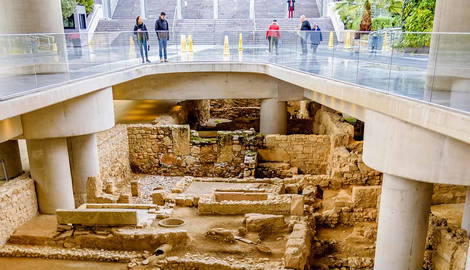
Known for its countless archaeological sites, busy nightlife, and quirky architecture, Athens welcomes millions of tourists every year. Although open-air sites are the most popular Athenian landmarks, there are also more than 70 museums and galleries to visit. Whether you are a history buff or an art aficionado, you will find at least one place you can add to your list of favorite museums. Visiting them all is an impossible task, so start with these seven best museums in Athens.
1. National Archaeological Museum

Situated close to Omonia Square, the National Archaeological Museum is the largest archaeological museum in Greece. It was established in the 19th century to protect and exhibit the ancient Greek artifacts recovered during the numerous archaeological excavations of that time. Few people know it was initially located on the island of Aegina. However, in 1858, a new neoclassical building was constructed at the heart of Athens, and the artifacts were relocated.

The National Archaeological Museum not only contains the largest collection of ancient Greek artifacts in the world, but it is also considered an architectural marvel. It was initially designed by the German architect Ludwig Lange, and later modified by Panagis Kalkos, Armodios Vlachos, and Ernst Ziller. Its façade, with its characteristic row of Ionic columns, makes the building easily recognizable from a distance.
Opening hours are 08:30-20:00, except Tuesdays, when the museum remains closed until 13:00. Admission fees range from 6€-12€, depending on the season. Due to its large size and the number of artifacts, it is not recommended to combine other museum visits on the same day.
Highlights

- The Golden Mask of Agamemnon and other precious gold funerary objects recovered from Mycenae and associated with the Greek forces of the Trojan war.
- The Antikythera Mechanism, an analog computer from 100 BCE used to measure celestial bodies, found in a Roman shipwreck off the coast of Greece.
- The Jockey of Artemision, a dynamic bronze statue of a young man riding a horse from the Hellenistic period, one of the few original Greek bronze statues to survive.
2. Benaki Museum of Greek Culture

The Benaki Museum was founded in 1930 in memory of Emmanuel Benakis, a Greek merchant and national benefactor who served as mayor of Athens in the early 20th century. The main museum, the Museum of Greek Culture, is housed in the beautiful neoclassical house of the Benaki family. It was donated to the Greek nation by Emmanuel’s children: Antonis, Alexandra, Penelope, and Argine.
Its permanent collections include historic heirlooms, ancient Greek and prehistoric artifacts, and Byzantine iconography, among other exhibits. In its post-Byzantine collection, visitors can see traditional clothing items from different parts of Greece. It is one of the few Athenian museums that sheds light on more recent history, between the 15th and 19th centuries, during the Frankish and Ottoman occupations of Greece.
The Benaki Museum also has a number of satellite museums in different parts of Greece, including Pireos 138, the Museum of Islamic Art, the Ghika Gallery, the Yannis Pappas Studio, the Toy Museum, and the Leigh Fermor House. The main museum is open every day, except Tuesdays, and admission fees vary from 1€-9€. It is located within walking distance of Syntagma Square or Evangelismos subway station.
Highlights

- Gold hair ornament with a bust of the goddess Athena on the emblem from the Thessaly/Karpenisi Hoard, 2nd century BCE.
- Gold and silver cups from the early third millennium BCE, when Greek culture was moving between the Stone and Bronze Ages.
- Two paintings by El Greco, Domenikos Theotokopoulos, created while living in Crete.
3. National Gallery (Alexandros Soutsos Museum)

One of the most important art museums in Athens is the National Gallery, located on Vasilissis Sophias Avenue, about 10 minutes on foot from the Benaki Museum. The jurist Alexandros Soutzos helped establish the museum in 1900 CE by donating his estate and art collection.
Unlike other local museums that exhibit ancient Greek and Byzantine art, the National Gallery displays Greek and international paintings from the 14th century to the present day. Its collections comprise more than 20,000 artworks, including historical paintings depicting scenes from the Greek War of Independence. The National Gallery also includes the National Glyptotheque, located at the Army Park in Goudi, Athens. The main building is open every day except Tuesday, and tickets cost between 5€-10€.
Highlights

- The Apotheosis of Athanasios Diakos, by Konstantinos Parthenis, 1933, as a fine example of Greek Cubism.
- Portrait of Mrs Serpieri by Nikephoros Lytras, 1869, considered the father of modern Greek painting.
- The Exodus of Messolonghi, by Theodoos Vryzakis, 1878, showing a tragic episode in Greece’s fight for freedom.
4. Byzantine and Christian Museum

Situated between the National Gallery and the Benaki Museum, the Byzantine and Christian Museum houses more than 25,000 Byzantine artifacts, including religious icons and manuscripts. Its collection showcases progression from the ancient world to Byzantium and Byzantium to the modern era.
The museum is housed in one of the most beautiful historical buildings of Athens. Known as Villa Ilissia, which used to belong to Sophie de Marbois-Lebrun, Duchess of Plaisance. Designed by the architect Stamatis Kleanthis in the 19th century, it combines elements from both Classicism and Romanticism. Due to the unconventional lifestyle of the Duchess of Plaisance, who had an interest in occultism, Villa Ilissia is one of the most mysterious Athenian buildings. More precisely, it has been the epicenter of countless urban legends involving secret séances and ghost sightings, a common interest among the members of the high society of the late 19th century.
The Byzantine and Christian Museum is open every day between 08:00-20:00, except Tuesdays, when it remains closed till 13:00. Admission fees vary between 4€-8€.
Highlights

- The 13th-century mosaic icon of the Virgin Mary from Constantinople.
- The Liturgy of St Spyridon, painted by the Lacedaemonian Panagiotis Doxaras in the early 18th century.
- Limestone panel with the figure of St John the Baptist from Timlos Prodromos Monastery in the early 17th century.
5. Acropolis Museum

One of the most recent additions to the Athenian cultural scene is the Acropolis Museum. It houses more than 4,250 ancient artifacts from the archaeological site of the Acropolis Hill, including the Caryatids. These were the marble maidens who carried the roof of the Erechtheion Temple on their heads. Although there were six in total, one Caryatid was taken by Thomas Bruce, also known as “Lord Elgin,” during the Ottoman occupation of Greece. The missing Caryatid is displayed at the British Museum.
The Acropolis Museum was founded in 2009 to restart the negotiations for the return of the Parthenon Marbles from the United Kingdom. It has replaced the first museum that was built in 1874 on the Acropolis Hill to safeguard the artifacts found on the site. One of the reasons the British Museum initially denied the return of the sculptures was the alleged “bad conditions” of the old building. The main motivation behind the completion of the new building was the elimination of such complaints.

Located close to the Acropolis Hill, the new museum can be recognized from a distance thanks to its unique modern design. The architect behind it was no other than the French-Swiss Bernard Tschumi, commonly associated with deconstructivism.
The Acropolis Museum is open every day of the week and the ticket prices vary between 5€-15€, depending on the season. The entrance is located right next to the Acropolis subway station.
Highlights

- Caryatid Kore B from the Erechtheion Temple, c. 5th century BCE.
- Relief of Athena Nike from the south parapet of the Erechtheion Temple, c. 5th century BCE.
- Marble statue head of Alexander the Great, c. 330-320 BCE.
6. Museum of Cycladic Art

Recognized for its minimalism and sophisticated simplicity, Cycladic art has been one of the main influences of modern art. The ancient Greek art movement, which flourished in the Aegean islands during the Bronze Age, has its own dedicated museum in Athens. The Nicholas P. Goulandris Foundation, also known as the Museum of Cycladic Art, is located two blocks away from the Benaki Museum. Housing more than 3,000 items from the private collection of Nicholas and Dolly Goulandris, it is one of the most popular museums in Athens. The collection of Goulandris has since been donated to the Greek state and the museum is a non-profit legal entity.
The Museum of Cycladic Art is based at the Stathatos Mansion, another beautiful neoclassical building with a rich history. Designed in 1895 by Ernst Ziller, the villa has a rich history, as most of the buildings on Vasilissis Sofias Avenue do. It can be reached easily from Syntagma Square and Evangelismos subway station, while it remains open every day of the week except for Tuesdays. Ticket prices vary from 6€-12€.
Highlights

- Marble statue of Artemis from Palaiopolis, 2nd century CE.
- The 6th-century BCE Kore of Thera, discovered in the excavation of the Thera cemetery.
- Post-Byzantine icon from Melos showing the rescue of a ship by the Virgin Mary.
7. Numismatic Museum

An important Athenian museum with one of the most impressive façades in the city is the Numismatic Museum. It houses a collection of over 500,000 coins, medals, and other related artifacts that often date back to 1400 BCE. Its permanent collections consist of a large number of ancient Greek and Byzantine coins, including a golden (Y)perpiron.
Established in 1834, it was initially considered a branch of the National Library of Greece. It took many years until it found its permanent location at Iliou Melathron, the former residence of the Schliemann family. The beautiful building is another work of Ernst Ziller, this time combining elements of the Neoclassical, Exotic, and Renaissance movements.
The Numismatic Museum of Athens is open every day except Tuesdays and Wednesdays, while ticket prices vary from 3€ to 15€. The building is located close to Syntagma Square, towards the Academy of Athens.
Highlights

- Hoard of gold coins from Epidaurus, 3rd century BCE.
- Octadrachm of Ptolemy II Philadelphus, c. 285-246 BCE, Egypt.
- A seal for the minting of Athenian tetradrachms from the 5th century BCE.
All Athenian museums remain closed during national holidays, such as Christmas day, with the exception of “Ohi Day” on the 28th of October. On that day, many museums are not only open but also offer free entrance to all visitors.









